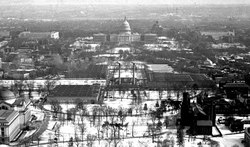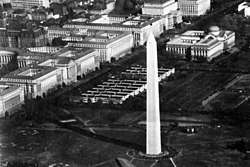Temporary buildings of the National Mall

The U.S. government constructed a number of temporary buildings on the National Mall during World War I and II which stood from 1918 until 1971. They were built due to the urgent need for office space during wartime, but they remained in use during peacetime even though they disrupted the intended layout of the Mall according to the McMillan Plan for over half a century.
In 1918, the Main Navy and Munitions Buildings were constructed alongside the Lincoln Memorial Reflecting Pool in West Potomac Park, and a cluster of six buildings was built in the center of the Mall in the vicinity of 7th Street. All but one of the latter six buildings was demolished by 1937. However, fourteen new temporary buildings were constructed throughout the Mall in 1942. Most of these stood until the mid 1960s, and the last one was demolished in 1971. Constitution Gardens, the National Museum of American History, National Gallery of Art, and National Air and Space Museum were all built at the locations of demolished temporary buildings.
Background
The 1902 McMillan Plan proposed an overarching layout for the National Mall based on City Beautiful principles, replacing the Victorian layout that existed at that point. Its early implementation prior to World War I included initiating the replacement of the old Department of Agriculture Building with the current headquarters, removal of the Baltimore and Potomac Railroad Station, and construction of the National Museum of Natural History.[1]: 48–52
The entry of the United States into World War I in April 1917 led to an expansion of the federal government, causing urgent need for new office space to be constructed. Park space on the National Mall was appropriated for this purpose. Although the buildings were intended to be temporary, the U.S. Commission of Fine Arts by 1918 suggested that they would likely remain in use long past the end of the war.[2]
East of the Washington Monument


World War I buildings
The government built a complex of temporary buildings in 1918 in the vicinity of 7th Street consisting of six lettered office buildings with an administration building, mechanical building, and restaurant at their center. They were designed by architect Horace Peaslee. The wards of the Armory Square Hospital had previously occupied the area during the Civil War, though the Armory building itself remained in use to the immediate south of the temporary buildings. Although they did not conform to the McMillan Plan, their footprints left space for the streets planned to cross the Mall. Many of the buildings were of wood construction, although Building E was concrete.[1]: 52–53 Unlike the other buildings, Building E was fireproof.[3]
Buildings A and B were demolished in the early 1920s.[4][5] Their site was assigned to the George Washington Memorial Building, whose foundation was constructed beginning in 1921, but the building was never completed. The site would later be used for the National Gallery of Art.[1]: 53, 72
After the war, the remaining buildings held offices for the Departments of Agriculture, Commerce, the Treasury, and War.[5] Building C contained offices of the Public Health Service beginning in July 1920, and became its temporary headquarters from April 1929, when the Butler Building was closed for demolition, and May 1933, when the new Public Health Service Building opened.[6]
Beginning in 1929, and accelerating with the inauguration of Franklin D. Roosevelt in 1933, impetus increased for further implementation of the McMillan Plan. In 1930, the Commission of Fine Arts blamed the temporary buildings for "producing a depressing air of slovenliness" on the Mall.[1]: 57 The central heating plant was seen as a priority to be demolished, as it sat exactly on the Mall's central axis. Demolition contracts were issued in May 1935.[1]: 57, 63, 65 The D Building had been demolished by 1934, and the C Building by 1935.[1]: 68–69 [7] The F Building was demolished by 1937, leaving only the E Building standing.[8]
World War II buildings


During World War II, the E Building remained from World War I, but the other letters were reused for different buildings in different locations, some of which were not on the Mall. During World War II, the temporary buildings clustered near 7th Street on the south edge of the Mall were Buildings D, E, R, and S. Additionally, Buildings T and U were built near 14th Street on the north side of the Mall.[9]
After World War II, Buildings E and R were occupied by the Veterans Administration, and Building S by the Department of Health, Education and Welfare.[10]
Buildings T and U were demolished in 1958 to make way for the construction of the National Museum of American History.[11] The buildings near 7th Street were demolished beginning in 1966.[12] Building E was the last temporary building on the Mall to be demolished, in 1971; part of the National Air and Space Museum would occupy its spot.[13][14]
West of the Washington Monument

Main Navy and Munitions Buildings
In 1918, contractors for the United States Navy's Bureau of Yards and Docks constructed the Main Navy and Munitions Buildings along nearly a third of a mile of the south side of Constitution Avenue (then known as B Street), from 17th Street NW to 21st Street NW.[15][16][17] Their construction was concurrent with that of the Lincoln Memorial and its Reflecting Pool during 1914–1922.[13] Although the Navy intended the buildings to provide temporary quarters for the United States military during World War I, the reinforced concrete structures would remain in place until 1970.[15][16]
The Main Navy and Munitions Buildings were demolished in 1970, with much of their former site becoming Constitution Gardens, which was dedicated in 1976.[16][18]
Later buildings
In 1942, the Main Navy and Munitions Buildings were joined by a larger set of temporary buildings.[13][19] Temporary Buildings 3, 4, and 5 to the pool's east housed the Navy's Bureau of Ships. Buildings I, J, K, and L to its south housed the Bureau of Supplies and Accounts. Buildings N and W were constructed to its north, adjoining the Main Navy and Munitions Buildings.[9][20] These buildings were all demolished in 1964.[13][19]
External links
![]() Media related to Temporary buildings of the National Mall at Wikimedia Commons
Media related to Temporary buildings of the National Mall at Wikimedia Commons
References
- ^ a b c d e f "Cultural Landscape Inventory: The Mall (Part 2)" (PDF). U.S. National Park Service. 2006. Retrieved 2021-02-22.
{{cite web}}: CS1 maint: url-status (link) - ^ "The Commission of Fine Arts Annual Report". U.S. Commission on Fine Arts. 1918. pp. 5–6.
{{cite web}}: CS1 maint: url-status (link) - ^ War Expenditures Hearings: Serials 1—Parts 1 to 13, inclusive, except part 9. U.S. House of Representatives. 1921. p. 629.
- ^ "Tuesday, February 1, 1921: Statement of Col. Clarence F. Ridley". District of Columbia Appropriation Bill, 1922: Hearings Before Senate Committee on Appropriations. United States Government Printing Office. 1920. p. 209. OCLC 671599351. Retrieved February 21, 2021 – via Google Books.
- ^ a b "Activities Occupying Buildings Under the Office of the Superintendent: State, War and Navy Buildings: Mall Buildings". Reorganization of Executive Departments: Hearings before the Joint Committee. United States Government Printing Office. 1924. p. 475. OCLC 908076577. Retrieved February 21, 2021 – via HathiTrust Digital Library.
- ^ Williams, Ralph Chester (1951). The United States Public Health Service, 1798–1950. Commissioned Officers Association of the United States Public Health Service. pp. 520–521.
- ^ Ives, James E.; Britten, Rollo H.; Armstrong, David W.; Gill, W. A.; Goldman, Frederick H., Office of Industrial Hygiene and Sanitation (March 1936). "Part I: Origin And Nature Of The Study: Locations Of Stations Where Observations Were Made In The Present Study". Public Health Bulletin No. 224: Atmospheric Pollution of American Cities for the Years 1931 to 1933. United States Government Printing Office. p. 10. Retrieved February 21, 2021 – via Google Books.
{{cite book}}:|work=ignored (help)CS1 maint: multiple names: authors list (link) - ^ "Public buildings in the District of Columbua" (map). Washington, D.C.: U.S. National Park Service. 1937. LCCN 87694427. OCLC 1686895. Retrieved 2021-02-23 – via Library of Congress.
{{cite web}}: CS1 maint: url-status (link) - ^ a b c "Public buildings in the metropolitan area of Washington, D.C." (map). Washington, D.C.: Federal Works Agency: Public Buildings Administration: Office of the Buildings Manager. 1946. LCCN 87694427. OCLC 1686895 – via Library of Congress.
- ^ Lewis, Tom (2015-10-13). Washington: A History of Our National City. Basic Books. ISBN 978-0-465-06158-7.
- ^ "Demolition of Temporary World War II Federal Buildings Prior to Museum of History and Technology Construction". National Portrait Gallery. 1958-06-23. Retrieved 2021-02-23.
{{cite web}}: CS1 maint: url-status (link) - ^ Kelly, John (2017-01-07). "Answer Man remembers the 'temporary' office buildings that once blighted D.C." Washington Post. ISSN 0190-8286. Retrieved 2021-02-21.
- ^ a b c d "Cultural Landscapes Inventory: Constitution Gardens" (PDF). U.S. National Park Service. 2008. pp. 22–24, 38, 41–42. Retrieved 2021-02-23.
{{cite web}}: CS1 maint: url-status (link) - ^ "Cultural Landscape Inventory: The Mall (Part 3)" (PDF). U.S. National Park Service. 2006. p. 76. Retrieved 2021-02-22.
{{cite web}}: CS1 maint: url-status (link) - ^ a b Main Navy Building: Its Construction and Original Occupants. Naval Historical Foundation. 1970-08-01. Retrieved February 21, 2021. Archived February 13, 2021, at the Wayback Machine.
- ^ United States Bureau of Yards and Docks (1921). "Chapter XXIII. Emergency Office Buildings, Potomac Park, Washington, D.C.". Activities of the Bureau of Yards and Docks: Navy Department: World War: 1917–1918. Government Printing Office. p. 480. Archived April 4, 2016, at the Wayback Machine.
- ^ "Constitution Gardens". National Park Service. Retrieved 2010-03-16. gsArchived August 28, 2010, at the Wayback Machine.
- ^ a b "Cultural Landscapes Inventory: Washington Monument Grounds" (PDF). U.S. National Park Service. 2009. pp. 46, 48. Retrieved 2021-02-23.
{{cite web}}: CS1 maint: url-status (link) - ^ "80-G-K-14433 Navy Department buildings, Washington, D.C." Washington, D.C.: Naval History and Heritage Command. Retrieved February 21, 2021. Archived November 29, 2020, at the Wayback Machine.
